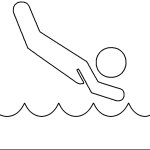Visual Impairment
Overview
Visual impairment (VI), which includes blindness, is
an impairment in vision that, even with correction, adversely affects a child’s educational performance. The term includes both partial sight and blindness (IDEA).
More than one-half of one percent of students qualifying for services under the IDEA have a VI designation (National Center for Education Statistics, 2022).
The visual impairment (VI) category is not a very prevalent type of disability among school-aged children.
Strengths
Students with visual impairment possess as many strengths as their neurotypical peers. They can perform in school with the same rigor as their peers. This type of disability in no way affects cognitive ability. Students with visual impairment also may have an increased sense of hearing, touch, smell, and taste. They are resilient and adaptable when it comes to learning and accessing materials and may learn how to process information orally or auditorily.
Needs
The needs of most student with visual impairment generally center on their lack of sight. Students with visual impairment may struggle with reading, making eye contact, and being able to read non-verbal social cues, as well as their balance and movement. Their self-esteem also may be impacted because, unlike others, they may rely on visual aids.
 Reflection
Reflection
Supporting Students with Visual Impairment
The section below explains some strategies for supporting students experiencing visual impairment. Based on what you have read so far, what strategies do you think might be useful for supporting students experiencing visual impairment?
Common Teaching Strategies
Paths to Literacy offers the following ways to help promote learning among students with visual impairment:
- Provide a variety of hands-on, meaningful experiences. Children learn best through real-world experiences where they can gain a firsthand understanding and not just a verbal explanation.
- Talk about these experiences with the child beforehand, as well as while the experience is happening, and after when you get home or with other people. Use words to label objects, people, and experiences that are appropriate to the child’s developmental level.
- Provide many opportunities for the child to explore and interact with a wide range of materials and real objects, which helps the child compare size, shape, texture and other attributes, while also helping the child develop basic concepts and an understanding of same and different.
- Encourage daily purposeful, fun movement activities to build gross motor and fine motor abilities, necessary precursors for many life skills, including the necessary tactile discrimination for functional object use and tactile symbols or braille.
- Support the child in interacting with others in safe and comfortable environments. Playful experiences and exposure to others with reciprocal give-and-take help to build the foundation for communication and social development.
- Create a literacy-rich environment, where the child knows that others are reading and writing.
- Provide accessible labels on the child’s chair, table, cubby, and any location for print labels, in the child’s preferred format (large print, braille, objects, tactile symbols). At home, label rooms in the house, light switches, controls on appliances, and other places for print labels.
- Read aloud using stories and books that are interesting and appropriate for the child. Use real objects and personal experiences to increase understanding. Link to story boxes.
- Determine the best medium for an individual child through the Learning Media Assessment (LMA). This may be braille, print, dual media, auditory strategies, objects, symbols, or some combination.
- Provide books and literacy tools in an accessible format to the child. (Strategies for Teaching Students Who Are Blind or Visually Impaired)
 Deeper Dive
Deeper Dive
Visual Impairment
For more information about visual impairment, review the following resources:
References
National Center for Education Statistics. (2022). Students With Disabilities. Condition of Education. U.S. Department of Education, Institute of Education Sciences.
U.S. Department of Education. (2018). Sec. 300.8 Child with a disability. Retrieved from https://sites.ed.gov/idea/regs/b/a/300.8
focuses on planning instruction in such a way to meet the varied needs of students at the point of first best instruction, thereby reducing the amount of follow-up and alternative instruction necessary
